UX Research in Health Apps: Design Thinking and Methodology Explained
Table of contents
- What Is UX Research, and Why Do Apps and Products Need It?
- Why Should Businesses Care About UX Research?
- Product benefits
- User benefits
- Business benefits
- How Is UX Research Conducted?
- Step 1. Planning
- Step 2. User recruitment
- Step 3. Data collection
- Step 4. Analytics and user testing
- Step 5. Data analysis
- Step 6. Insights and reporting
- Step 7. Iteration and implementation
- Design Thinking in UX
- Methods of UX Research: Tools and Types
- Primary and secondary UX research
- Quantitative and qualitative UX research
- Generative and evaluative UX research
- How Can Emerline Help?
Abandonment rates of health apps pose a significant challenge in the mHealth landscape. Understanding the underlying reasons behind this issue is crucial to addressing user dissatisfaction and improving app engagement. Involving end users 一 such as health professionals and patients 一 in the early stages of health app design is paramount to identifying their specific needs and preferences. This user-centric approach ensures that the app aligns with user expectations, leading to enhanced user satisfaction and increased app retention.
Delve deeper into the world of user research in health app development and gain valuable insights. Keep reading to uncover more about the methodologies, best practices, and success stories that drive the creation of user-centered and impactful health apps with Emerline's profound expertise in user experience research.
What Is UX Research, and Why Do Apps and Products Need It?
User research is crucial in app development across various domains. However, in healthcare app development, user research takes on an even more significant role as an essential practice focused on understanding users' needs, motivations, and behaviors. By collecting feedback and conducting in-depth investigations, user research provides valuable insights that guide the design and development of healthcare apps. It helps identify user pain points, validate assumptions, and ensure that the app meets the needs of its users.
Why does user research matter? With approximately 41,000 health apps available on the App Store and 54,000 on Google Play, the market is saturated with options. However, despite the vast selection, app retention rates remain low. Research indicates that the annual health app retention rate in 2021 was only 20%, suggesting a significant number of apps are abandoned by users.
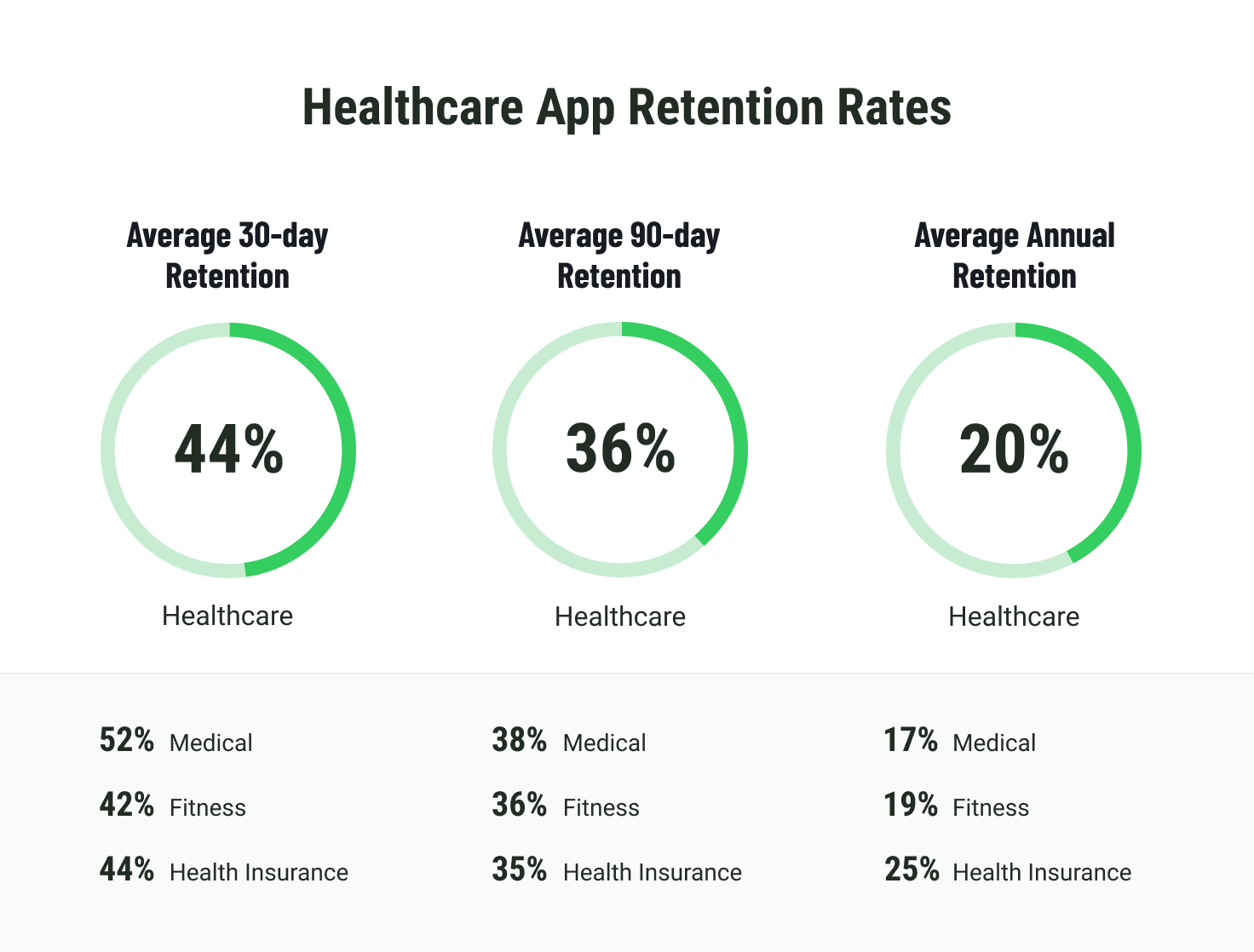
The reasons that users abandon mhealth apps can vary significantly. A recent study revealed that often, participants download multiple apps and select the most suitable one while deleting the rest (21.5%). Additionally, the absence of desired features (18.7%) and lost motivation (32%) were identified as key factors contributing to user dissatisfaction. All these challenges and reasons for health app abandonment can be effectively addressed if companies prioritize and conduct comprehensive user research.
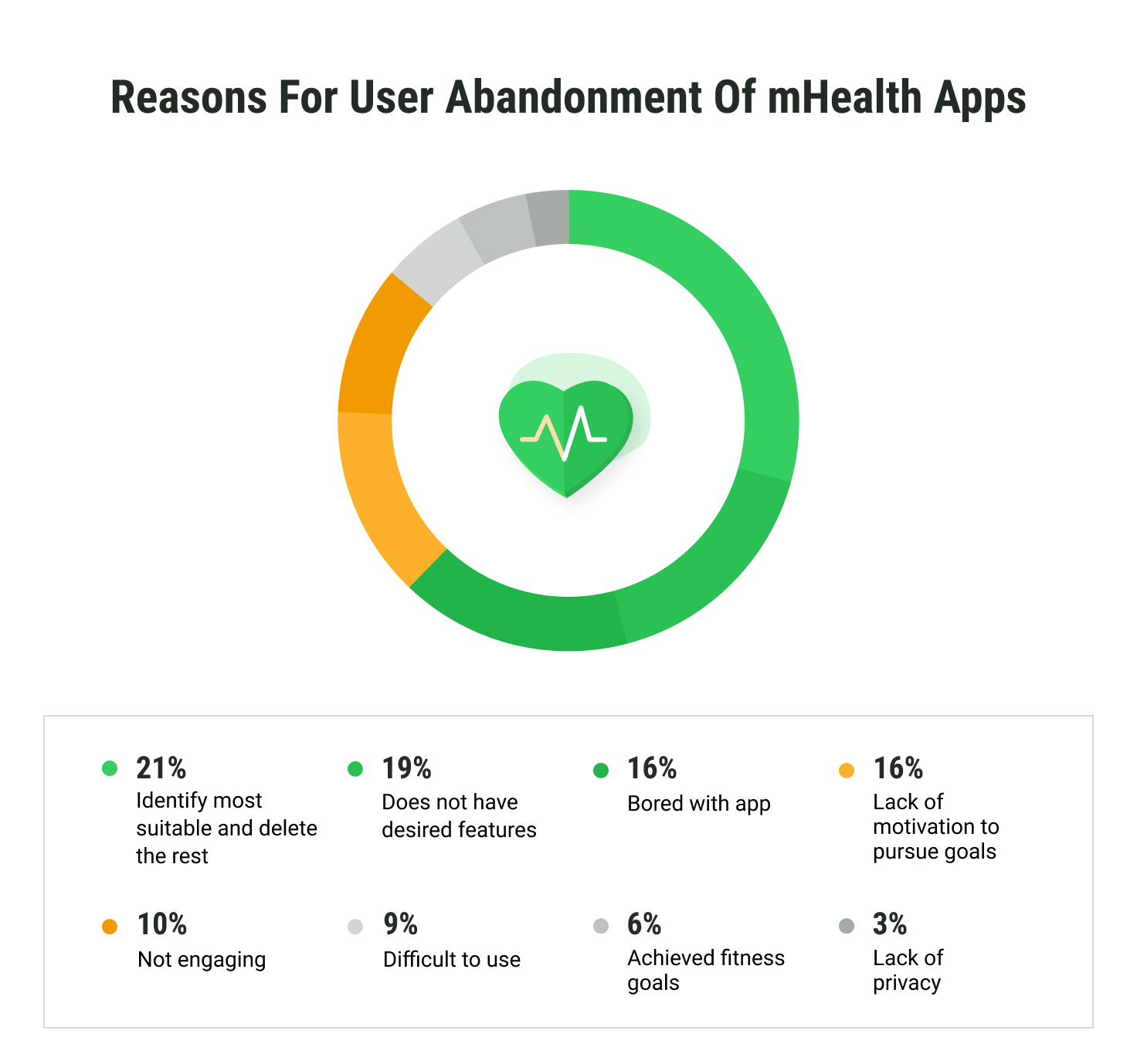
Why Should Businesses Care About UX Research?
User research in the context of product development, whether in the health industry or other industries, benefits the product, the users, and the business in several ways:
Product benefits
Improved design
User research provides insights into user needs and expectations, allowing businesses to design products that effectively meet those requirements. It helps in creating intuitive interfaces, functional features, and visually appealing designs.
Optimized usability
By conducting usability testing and gathering feedback from users, businesses can identify areas of improvement and make iterative changes to enhance the usability of the product.
Prioritized features
User research helps in understanding which features or functionalities are most important to users. This insight enables businesses to prioritize development efforts and focus on delivering value where it matters most.
User benefits
Enhanced user experience
User research ensures that products are designed with the end user in mind. By understanding their goals, pain points, and preferences, businesses can create user experiences that are intuitive, enjoyable, and efficient.
Tailored solutions
User research allows businesses to develop products that address specific user needs, offering customized solutions and improving overall user satisfaction.
Increased accessibility
By conducting research, businesses can identify barriers faced by users with disabilities or different abilities. This knowledge helps in designing inclusive products that are accessible to a wider range of users.
Business benefits
Market validation
User research helps in validating product ideas and concepts before investing significant resources in development. It minimizes the risk of developing products that do not resonate with the target audience.
Competitive advantage
By understanding user needs and preferences better than competitors, businesses can develop products that outperform their rivals in terms of user satisfaction, thus gaining a competitive edge.
Return on investment
User research reduces the likelihood of developing products that fail to meet user expectations. By aligning products with user needs, businesses can improve customer retention, increase sales, and achieve a higher return on investment.
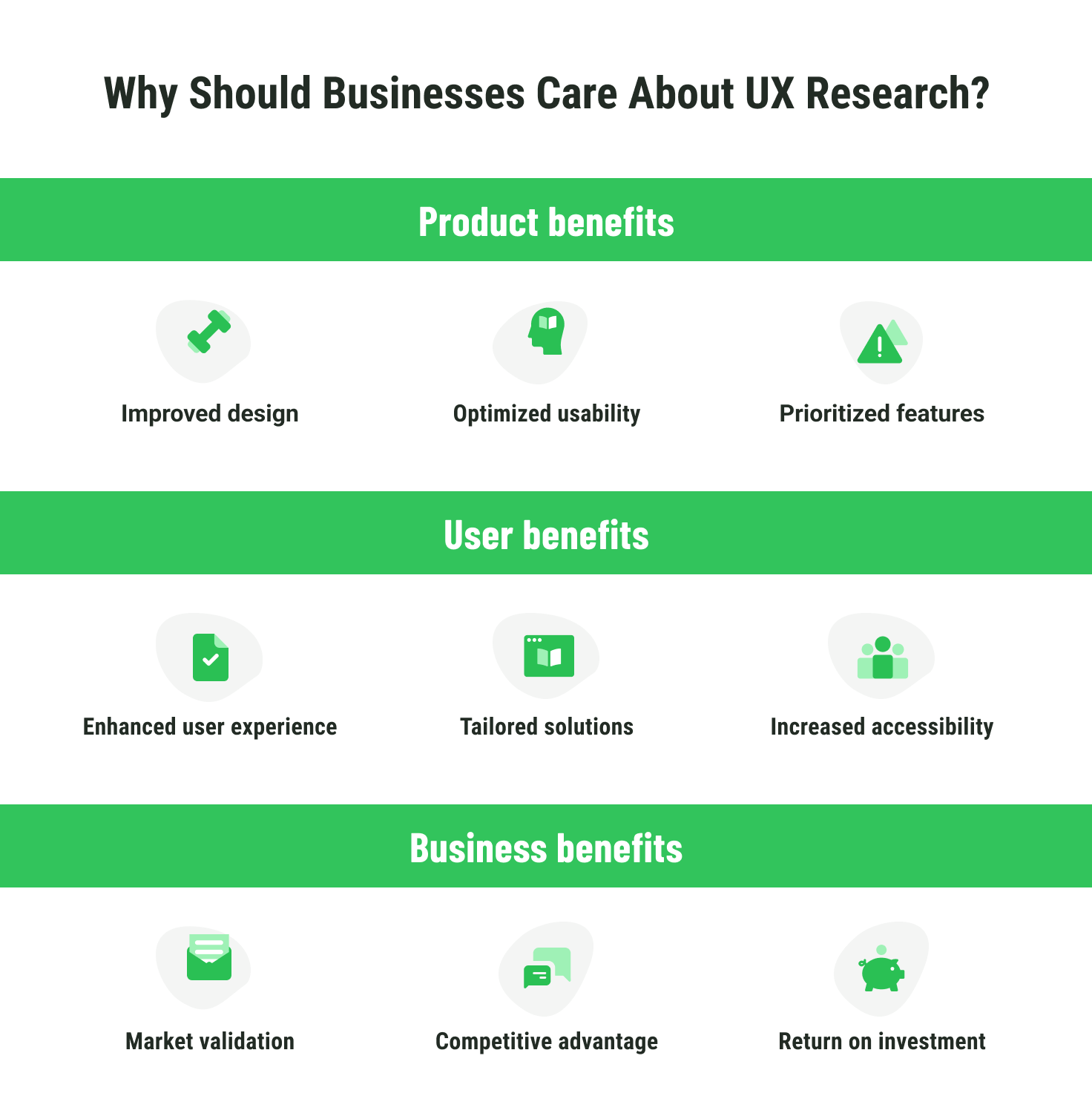
While the principles of user research remain consistent across industries, there are some anomalies specific to the health industry:
- Ethical considerations. User research in the health industry must adhere to strict ethical guidelines to protect the privacy and well-being of participants. Special attention is given to obtaining informed consent, maintaining confidentiality, and ensuring the research is conducted in an ethical manner.
- Regulatory compliance. The health industry is heavily regulated, and user research must comply with regulations such as HIPAA (Health Insurance Portability and Accountability Act) in the United States. This includes handling sensitive patient data and ensuring data security.
- Focus on health outcomes. User research in health often emphasizes understanding the impact of products or interventions on health outcomes, patient safety, and quality of care. It involves gathering feedback from healthcare professionals, patients, and other stakeholders to develop solutions that effectively improve health outcomes.
- Inclusion of diverse user groups. Health conditions can affect individuals across different demographics and with varying levels of health literacy. That’s why user research in health requires consideration of the needs and abilities of diverse user groups to ensure that products and services are accessible and beneficial to all.
These anomalies highlight the importance of conducting user research with care and sensitivity, taking into account the unique challenges and requirements of the health industry.
How Is UX Research Conducted?
Conducting UX research typically involves several stages, which can vary depending on the specific project and context. Here are the stages commonly followed in UX research:
Step 1. Planning
Define research objectives, identify target users, and determine the scope and methodology of the research. This stage involves setting research goals, creating research questions, and planning the logistics.
Step 2. User recruitment
Identify and recruit participants who match the target user profile. This can be done through various methods, such as online surveys, user panels, or recruiting agencies. Ensure that appropriate sample size is selected to gather meaningful insights.
Step 3. Data collection
Employ various research methods to collect data. Common methods include:
- Interviews: Conduct one-on-one interviews with users to gain in-depth insights into their behaviors, needs, and experiences.
- Surveys and questionnaires: Gather quantitative data from a larger user sample by asking structured questions.
- Observations: Observe users in their natural environment or through usability testing to understand their interactions with a product or service.
Step 4. Analytics and user testing
Analyze quantitative data from analytics tools or conduct usability tests to evaluate user interactions and identify pain points.
Step 5. Data analysis
Organize, analyze, and synthesize the collected data. Look for patterns, trends, and key findings that address the research objectives. This stage may involve categorizing qualitative data, conducting statistical analysis, and extracting insights.
Step 6. Insights and reporting
Summarize the research findings into actionable insights. Create reports or presentations that effectively communicate the insights to stakeholders, such as designers, developers, and decision-makers.
Step 7. Iteration and implementation
Use the research insights to drive the design process. Make iterative changes to the product or service based on user feedback and evaluation. Test and refine prototypes, conduct usability testing, and involve users throughout the design process.
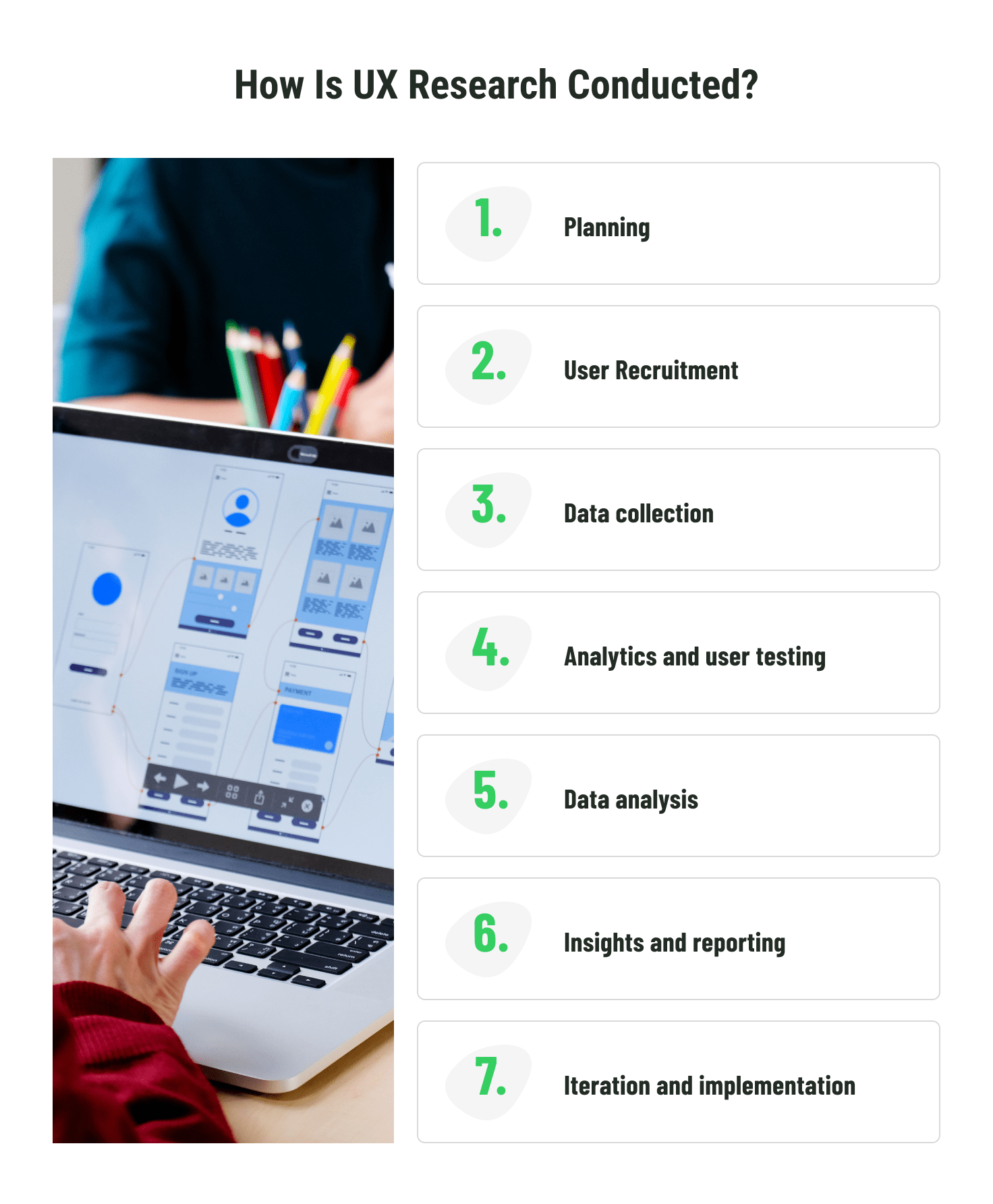
Design Thinking in UX
Design thinking plays a crucial role in user research. Design thinking in UX research refers to a human-centered approach that focuses on understanding user needs and integrating them into the design process. It involves the following key measures:
- Empathy. Gain a deep understanding of user needs, motivations, and pain points through research and observation. Develop empathy for users to design solutions that truly address their problems.
- Define. Clearly define the problem or challenge based on user insights. Frame the problem statement to ensure a targeted and focused approach.
- Ideate. Generate a wide range of ideas and potential solutions. Encourage a collaborative and creative environment where diverse perspectives contribute to ideation.
- Prototype. Create low-fidelity prototypes or mockups to quickly visualize and test potential design solutions. Prototyping allows for iterative testing and feedback from users in the early stages of the project, even before the development phase begins.
- Test. Conduct usability testing and gather user feedback on the prototypes. Evaluate how well the designs meet user needs and make necessary refinements.
Following Design thinking when conducting UX research helps teams approach problems from a user-centered perspective, fostering innovation, collaboration, and a focus on creating meaningful and effective experiences for users.
Methods of UX Research: Tools and Types
User research methods play a pivotal role in this process, enabling businesses to gain valuable insights into user behaviors, motivations, and expectations. They help businesses make informed decisions, enhance product usability, and ultimately deliver exceptional user experiences. Here are the most reliable UX research methods:
Primary and secondary UX research
Primary research is a quick and straightforward method for gaining insights into target users. It aims to validate design ideas early in the design process, helping the design team understand who will be using their product and why. Primary UX research tools include interviews, questionnaires, and surveys.
Secondary research involves gathering information from books, internet sources, and existing studies related to the subject. This type of research supports primary research or helps validate design ideas.
Quantitative and qualitative UX research
Quantitative research focuses on measurable results, providing numerical data to answer questions of "how many" and "how often." It explains what is happening.
Qualitative research delves into the motivations and behaviors behind user actions, explaining why something is happening. It uncovers the reasons and impulses that shape the user experience.
Generative and evaluative UX research
Generative research focuses on collecting information about users and their behavior to effectively define and solve problems. It is typically conducted in the early stages of the research process and may continue in smaller scales to clarify specific issues.
Evaluative research, on the other hand, is conducted throughout the design and development lifecycle. Its purpose is to assess an existing product and determine whether it meets user expectations.
Each research method offers unique advantages and focuses on different aspects of user behavior and preferences. However, companies typically employ a combination of user research methods to gather comprehensive and actionable insights.
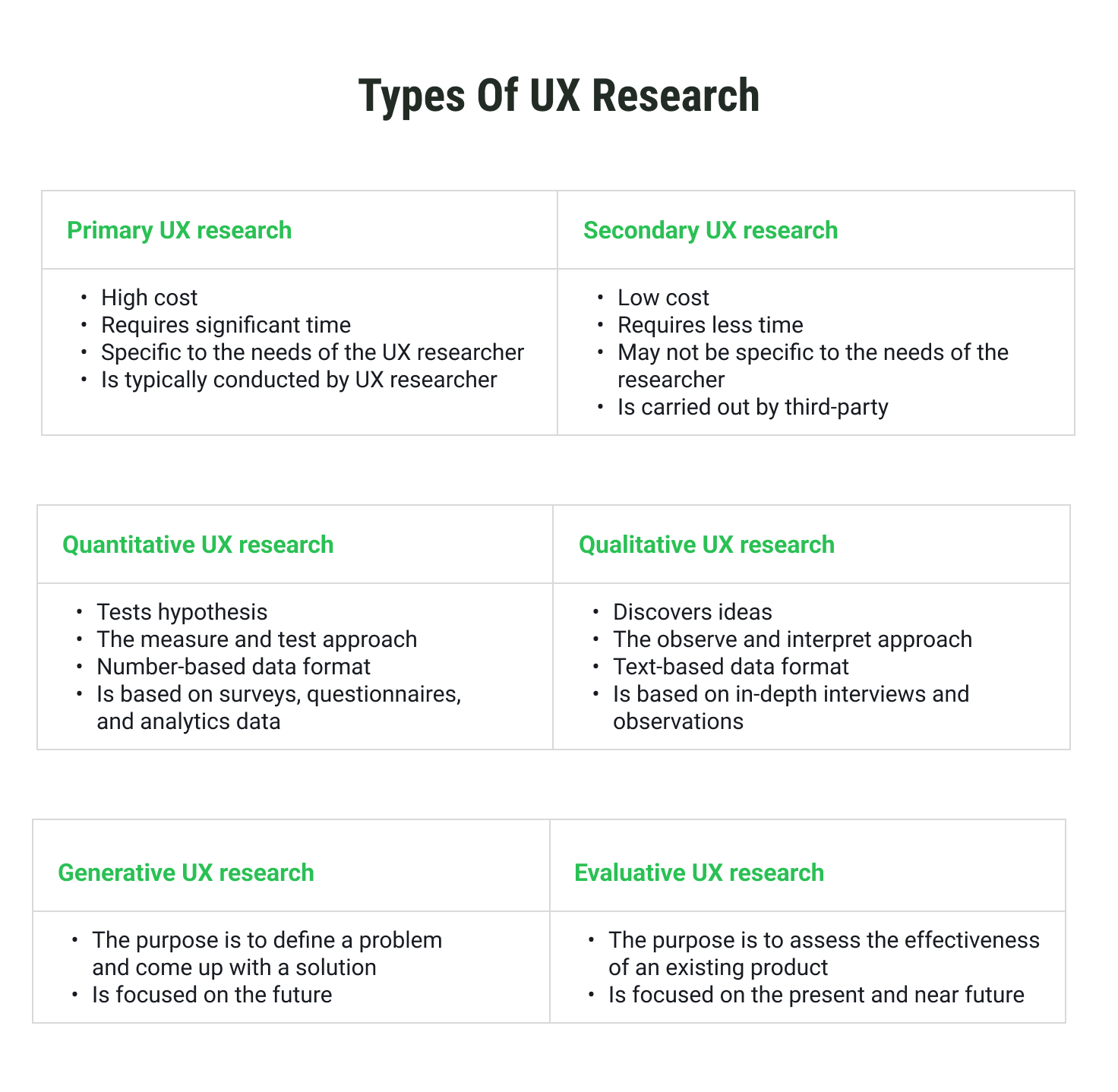
How Can Emerline Help?
Emerline specializes in comprehensive user research to understand your audience, gather valuable insights into their behavior, and tailor your application to their needs. With over a decade of experience in UX, our team of experts offers a range of services including UX consulting, UX audit, UX testing, mobile UX research, and remote UX research.
We provide guidance on the best UX methods and strategies, conduct thorough audits to identify weaknesses, and utilize various testing approaches to enhance the user experience. Contact us for a free consultation and unlock the power of user research for your applications.
Published on May 2, 2025





